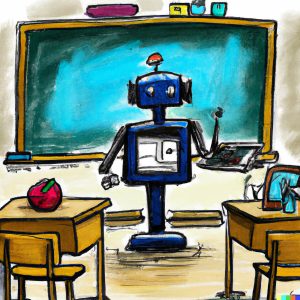Image Credit: Photo by Stanley Morales
Days into 2023, the New York City Department of Education instituted a ban on the use of ChatGPT in the district’s public schools. It was just the first educational body to do so. About a month later, several other institutions had joined it, both within the US (the district of Seattle) and outside it (Australia, France, and India).
Claims of the AI having negative effects on students’ education were cited as the main reasoning behind the bans. And they work similarly, by blocking access to the AI over school networks and on their devices.
What is ChatGPT?
ChatGPT is a chatbot developed by the artificial intelligence research laboratory OpenAI, based in the city of San Francisco. It was released to the public on the 30th of November, 2022. It requires users to create an account with OpenAI in order to interact with the chatbot.

The popularity of OpenAI’s ChatGPT is due to the closeness of its output to human responses.
Image Credit: © Tada Images / Adobe Images
Though not the first of its kind, ChatGPT is, by far, the most advanced offering of the AI community/industry. It is based on the GPT-3 language model, also written by OpenAI, released in the year 2020. The “GPT” stands for Generative Pre-trained Transformer. AI tools using this model rely on deep learning to generate text that is similar to human text/speech.
The chatbot has clearly proven to be very popular—within two months of its release, over 100 million users had registered to use it, making it the fastest app ever to cross that particular milestone. The massive interest in ChatGPT is attributed to how close its output is to that of human responses. It achieves this due to its training data, which consists of the largest dataset used for an AI till date. It also includes a vast number of real human responses to various sorts of queries and prompts.
Concerns Surrounding the Use of ChatGPT in Education
Since its release, much has been written and speculated about the changes the chatbot could have the potential to bring about. It has excited some people, while others are more focused on its negative consequences.
A field in which ChatGPT has become the source of a great deal of upset is education. Within weeks of its launch, teachers realized that some students had already begun using the chatbot to generate text that replaced what could otherwise have been their own original work in written assignments. It is this use, or misuse, more than anything else, that has set off the most alarm among educators.
Written assignments are a staple aspect of education. They have been utilized across subjects and levels of education and are common tools to promote learning and assessment. Students are frequently required to submit essays and papers with the goal that they gain greater clarity on the topics they are writing about while also developing their communication skills. The submissions also become a means for teachers and educators to gauge the same.

Written assignments are an important part of the current systems of education and assessment.
Image Credit: Photo by Pixabay
As old as the written assignment is, it is also a method of assessment that has been subject to cheating. For years, students have looked for ways to get around all the work required to produce a well-written essay or paper. Cheating on written assignments usually takes the form of plagiarism, a grave offense in academia that can have severe consequences including, but not limited to, the student’s expulsion from the institution.
The introduction of ChatGPT has whipped up a flurry of concerns about the impact of AI on academic integrity accompanied with a new debate on originality. The text ChatGPT generates is not picked from another document (as happens in the conventional understanding of plagiarism) but is, in fact, original. It may be able to pass the plagiarism detectors that are used to scan the writing that students submit. Thus, some could argue that using it does not amount to plagiarism. However, the AI is incapable of independent critical thinking and the paper submitted is devoid of any actual originality of thought and/or message.
Both critical analysis and originality of thought are important in academia and research as it is these elements that drive further exploration and study. So far, the primary means through which these have arisen, and are documented, is through writing. In such a scenario, widespread use of AI text generators becomes a cause for concern among academics. This is exacerbated by the evident loss of learning opportunity for students that a replacement of the writing process by ChatGPT is likely to cause.

Lack of original thought and accuracy of information are concerns that plague the content produced by text generative AIs.
Image Credit: © MrVettore / Adobe Stock
ChatGPT’s ability to collate and present information may also turn it into a tool for research. However, this too does not sit well with many teachers. While it does have access to a considerable database, that database is not connected to the internet. Thus, ChatGPT’s information is up to date only until 2021. It is not aware of current developments, and this can cause it to churn out content that is factually out of date.
Simultaneously, the accuracy of the information ChatGPT presents is also suspect. The chatbot appears to have the ability to, sometimes, make up facts and present them as the truth, a concern that has also been expressed by OpenAI’s CTO (chief technology officer), Mira Murati.
This flaw is not one that ChatGPT is subject to alone, but rather one that has plagued most other AI tools as well. Another such common AI defect that also surfaces in ChatGPT is AI bias. While not overt, the chatbot is subject to the same biases and prejudices inherent in its developers, passed on through the training data.
These are the main reasons propping up the bans against ChatGPT and its use in academic institutions. (Similar bans have also been declared in other arenas, such as the online forum Stack Exchange and the International Conference on Machine Learning).
The Alternative to Banning ChatGPT
Even as more and more schools and colleges continue to prohibit the use of ChatGPT, some educators and experts in the field question them.
They argue that, for one, these bans are futile and easily breached by students determined to use the tool. Secondly, and more importantly, they question the wisdom of trying to keep AI out of academia.

Detractors of the bans on ChatGPT argue that AI ought to be integrated into classrooms and educational systems.
Image Credit: Alexandra_Koch from Pixabay
AI is clearly here to stay. The technology is only going to develop further, and attempts to prevent students from accessing and using them are likely to end up being in vain. The argument goes further to point out that they may, in fact, be damaging.
Instead, advocates for AI call for it to be integrated into the educational system for students. They see it as the future anyway, and resisting it now can only cause problems and confusions down the road. Speaking to Cosmos Magazine, Professor George Siemens from the University of South Australia also sees great potential in the tool as a teaching aid. He says, “Teaching is rapidly changing. By embracing new technologies, and learning how AI can complement teaching, we can prepare students for a future where they will be able to compete with the best and brightest.”
But integration of such technology may result in a much larger overhauling of the way the system currently works. On the other hand, some teachers are already trying out ways of doing so.
As the situation stands right now, several of the questions asked, by both sides, have no concrete answers. The concerns of those banning ChatGPT are valid and urgent, but the suggestions of its supporters cannot be disregarded either. It may be a while before solutions regarding the matter of AI in classrooms may be arrived at.
